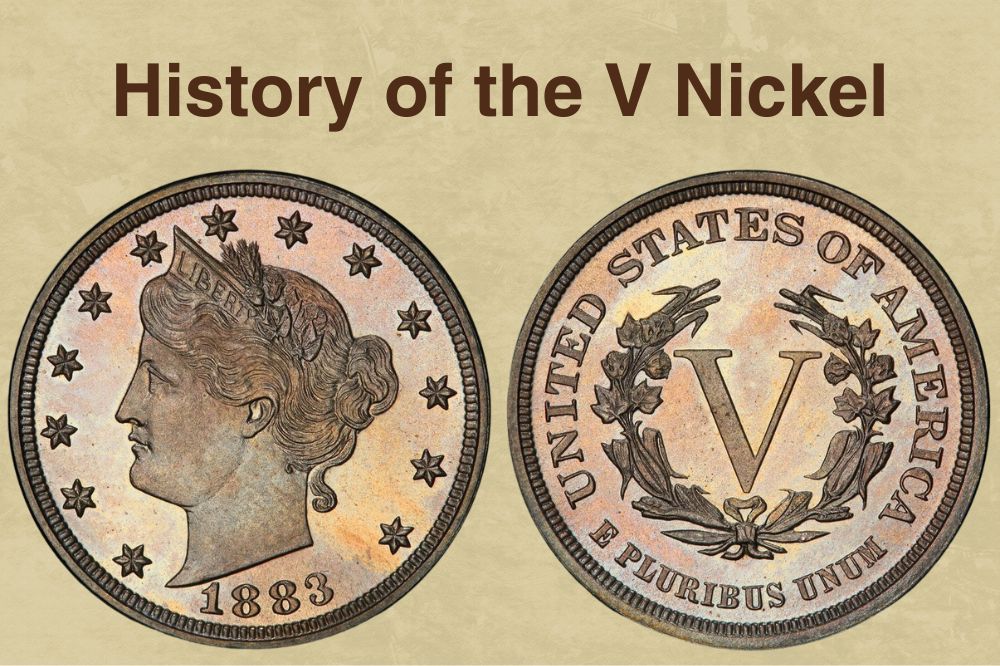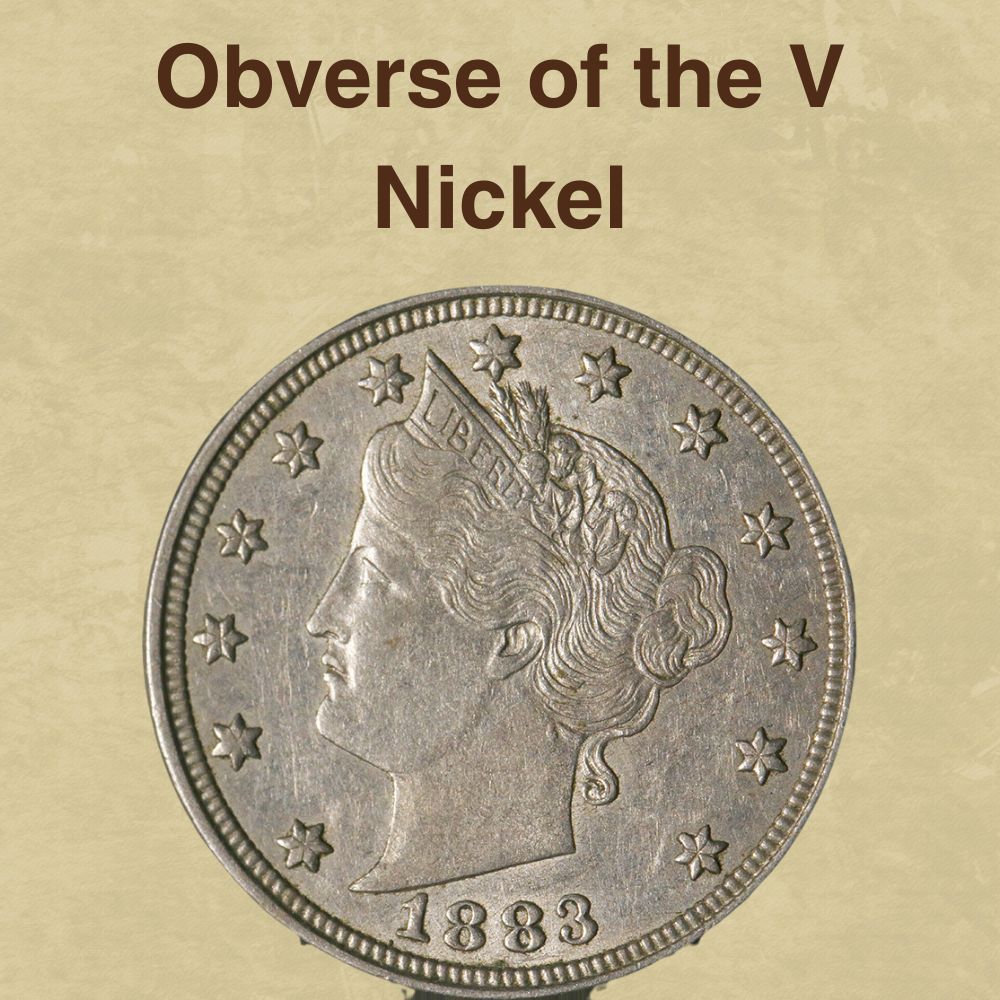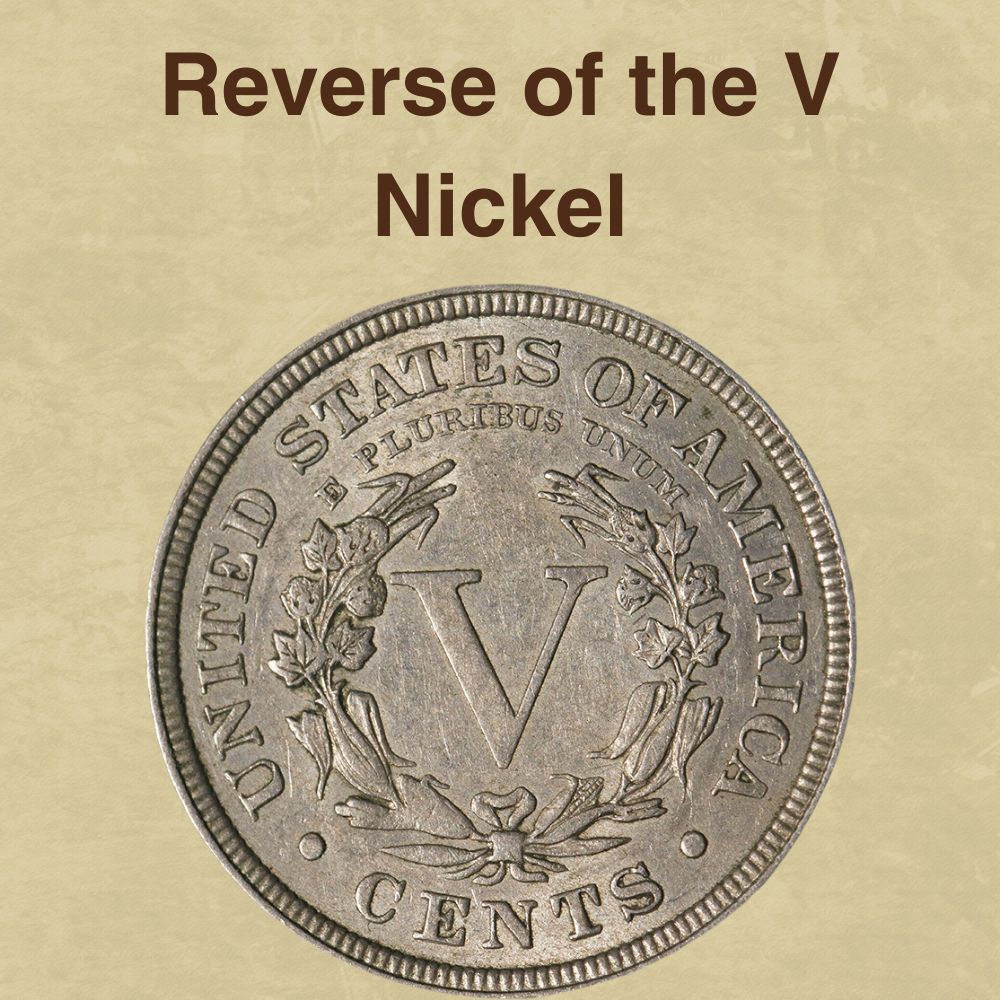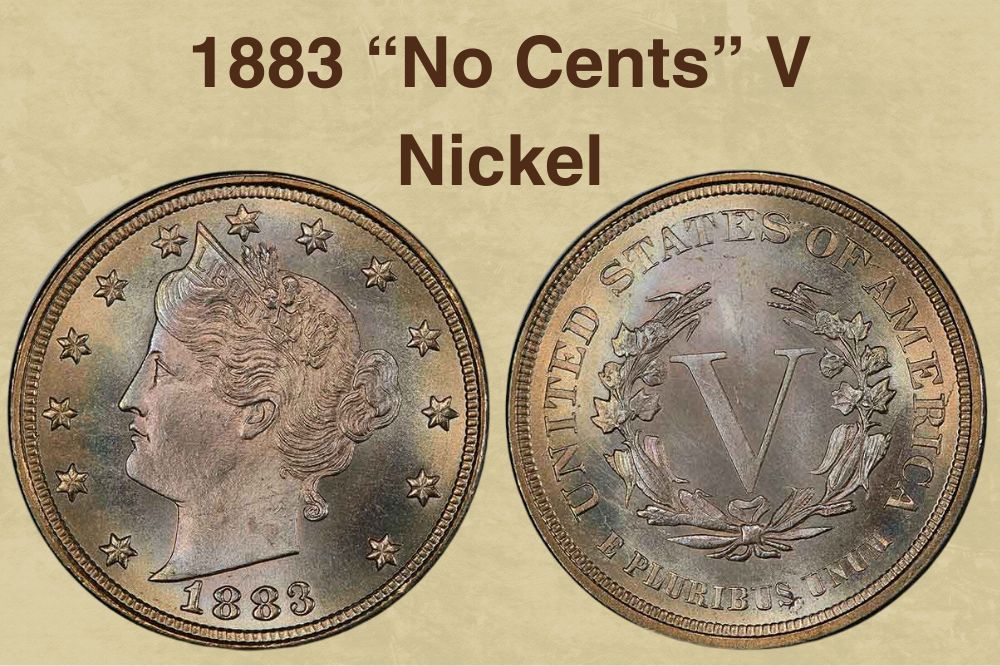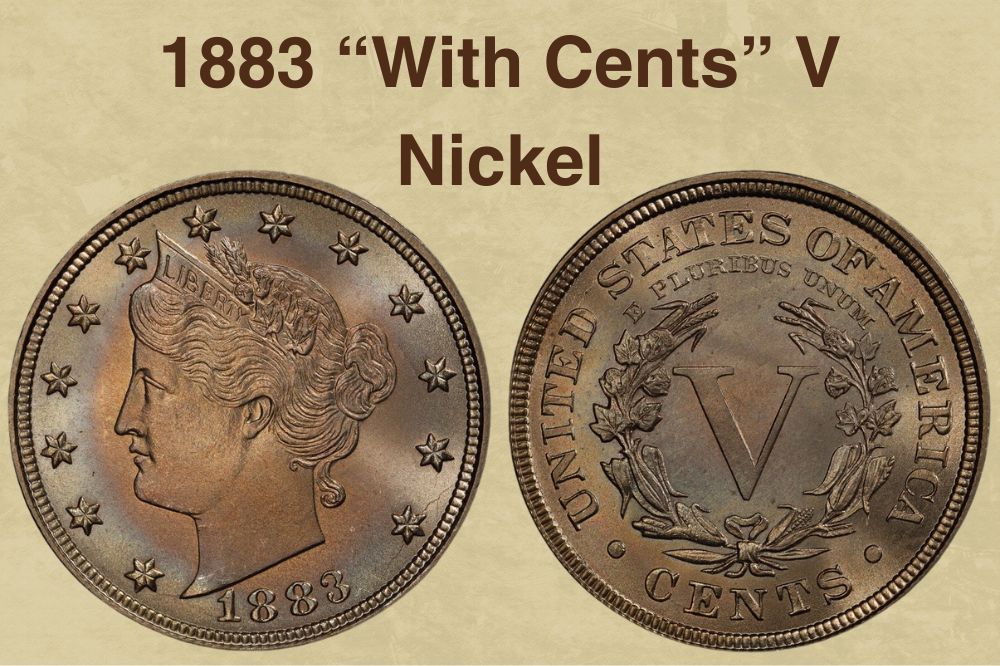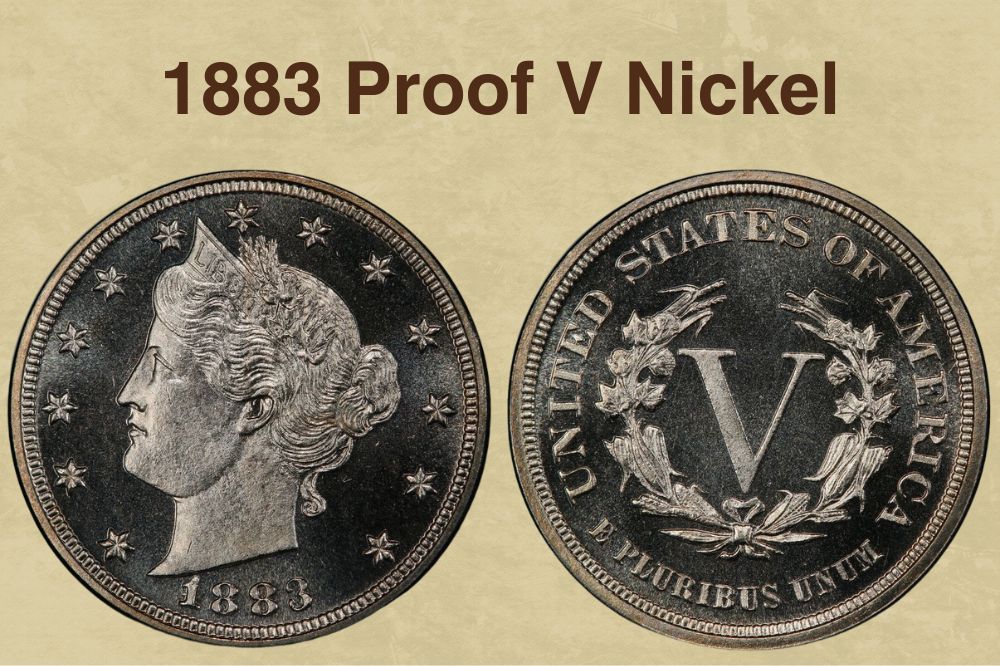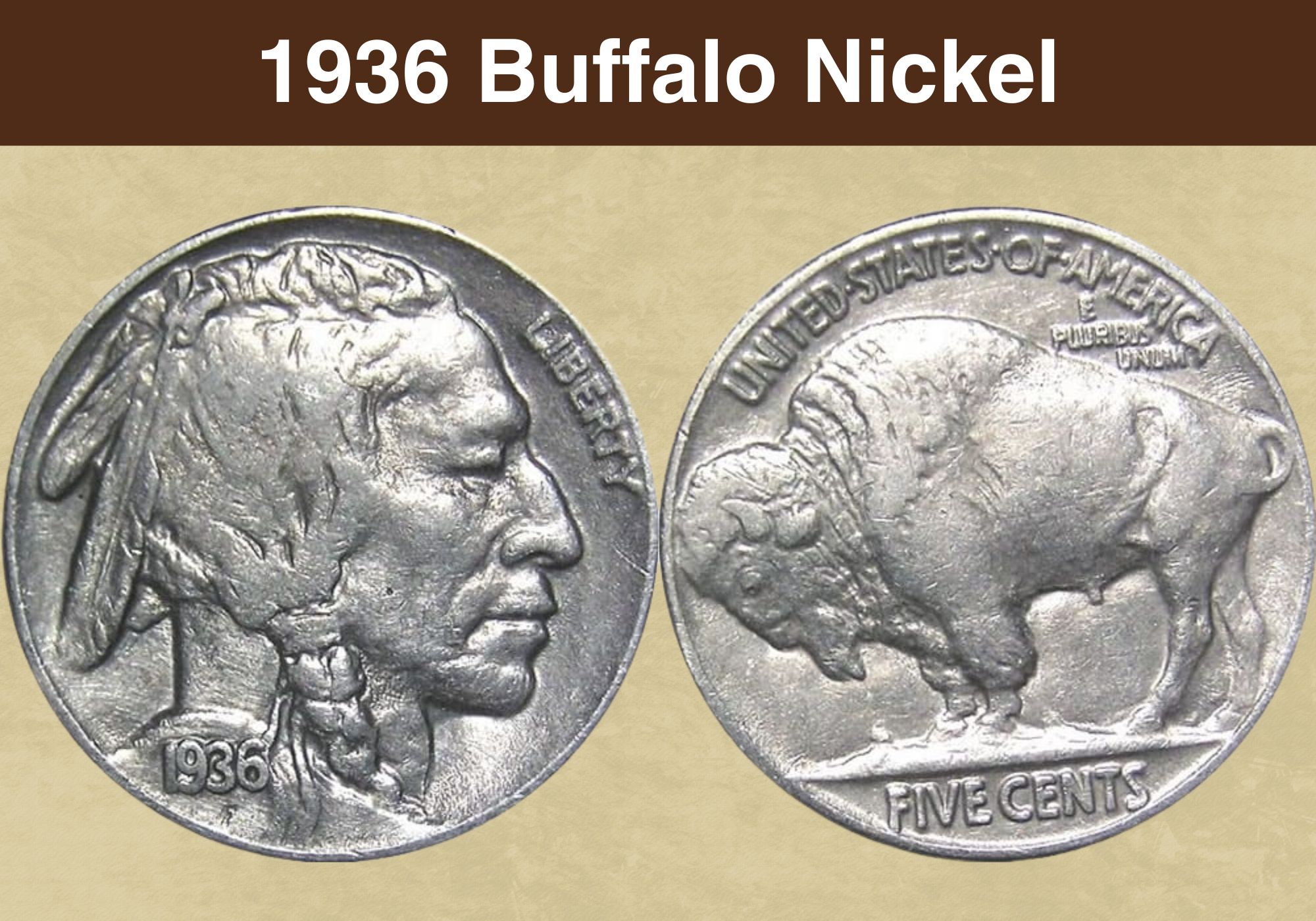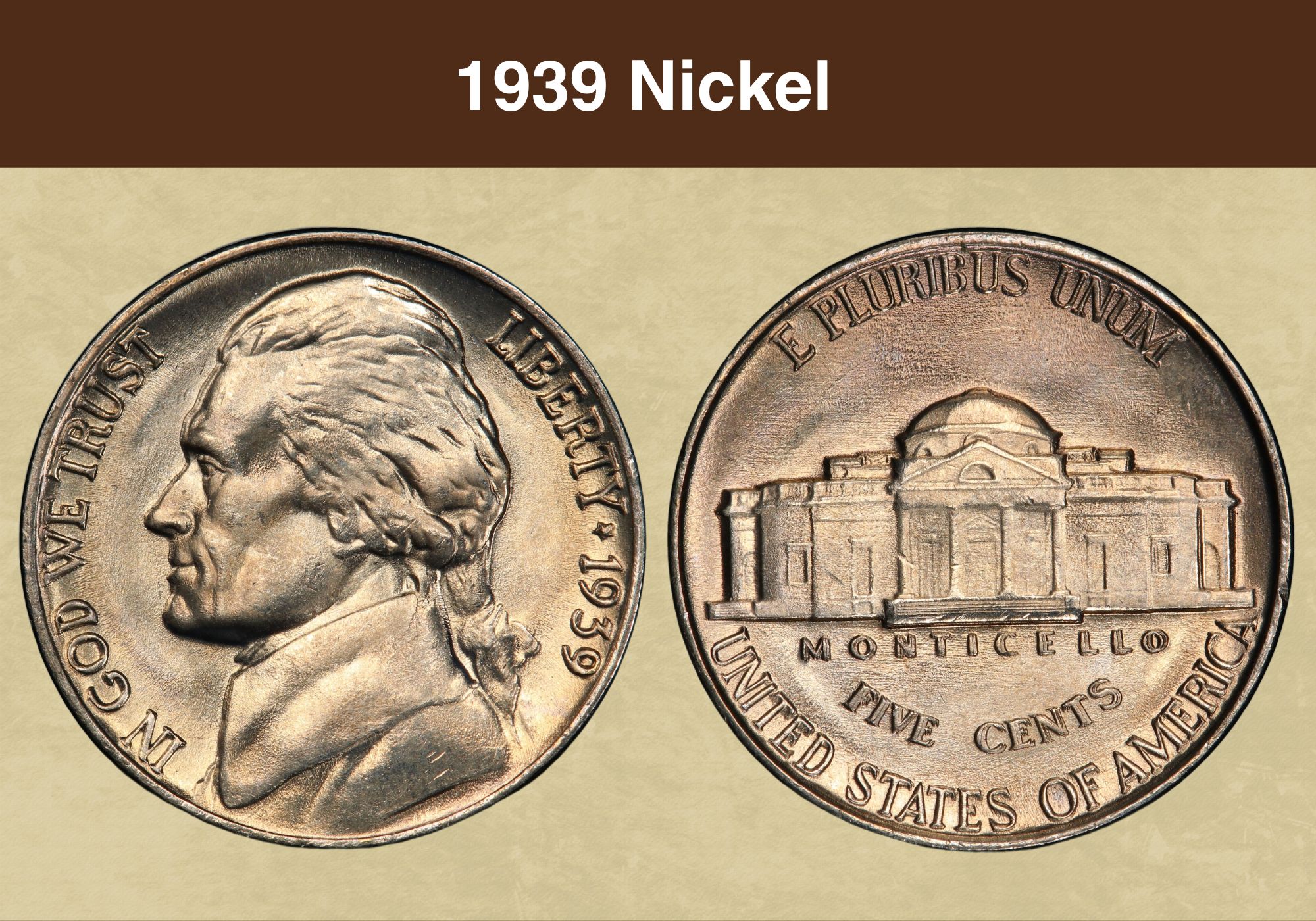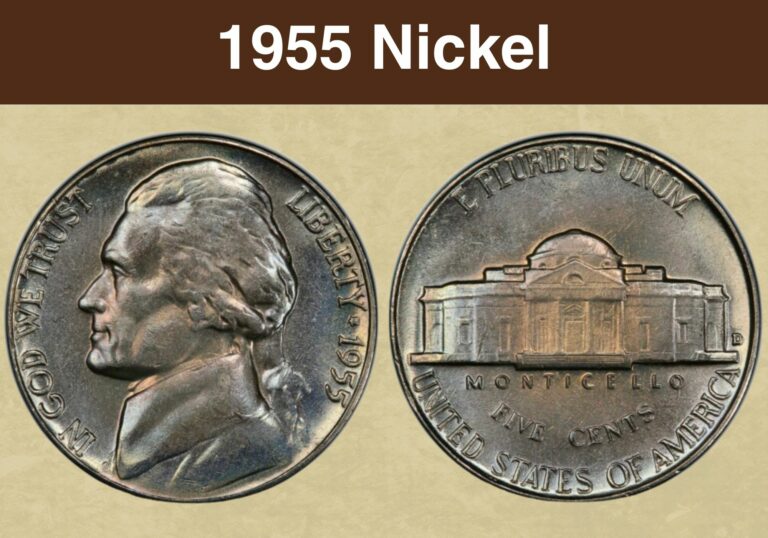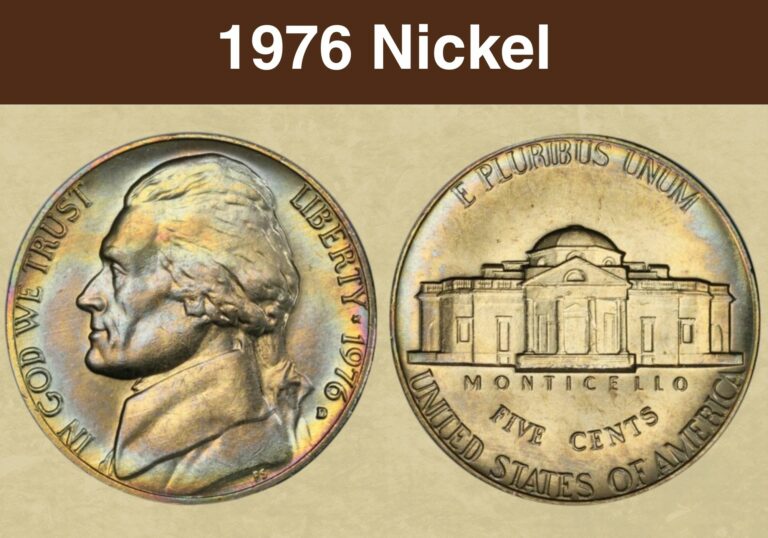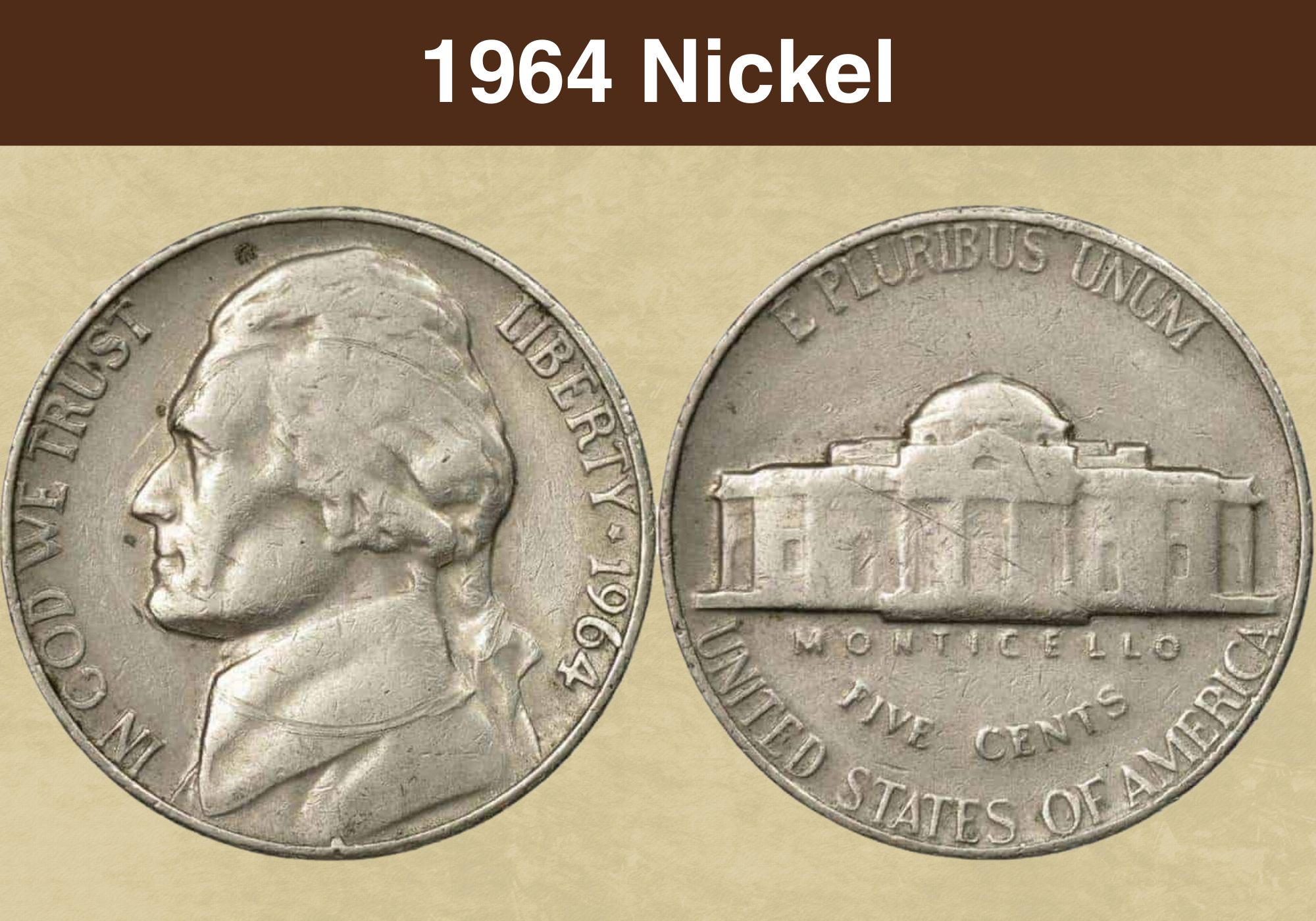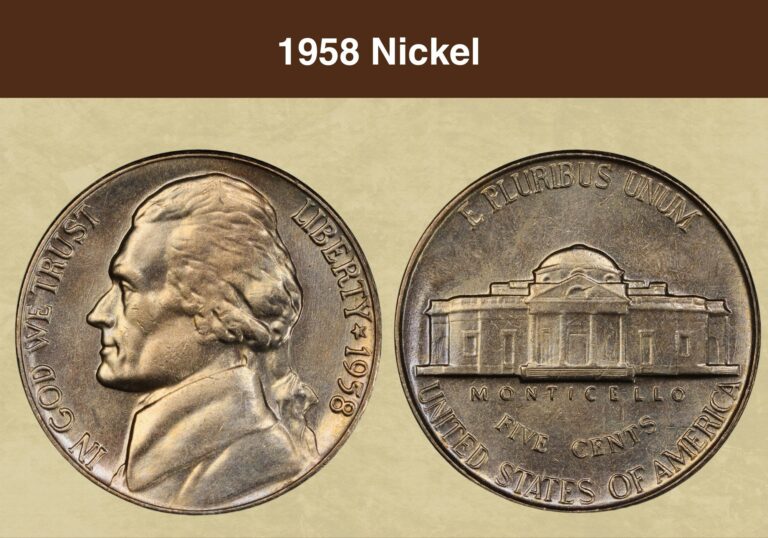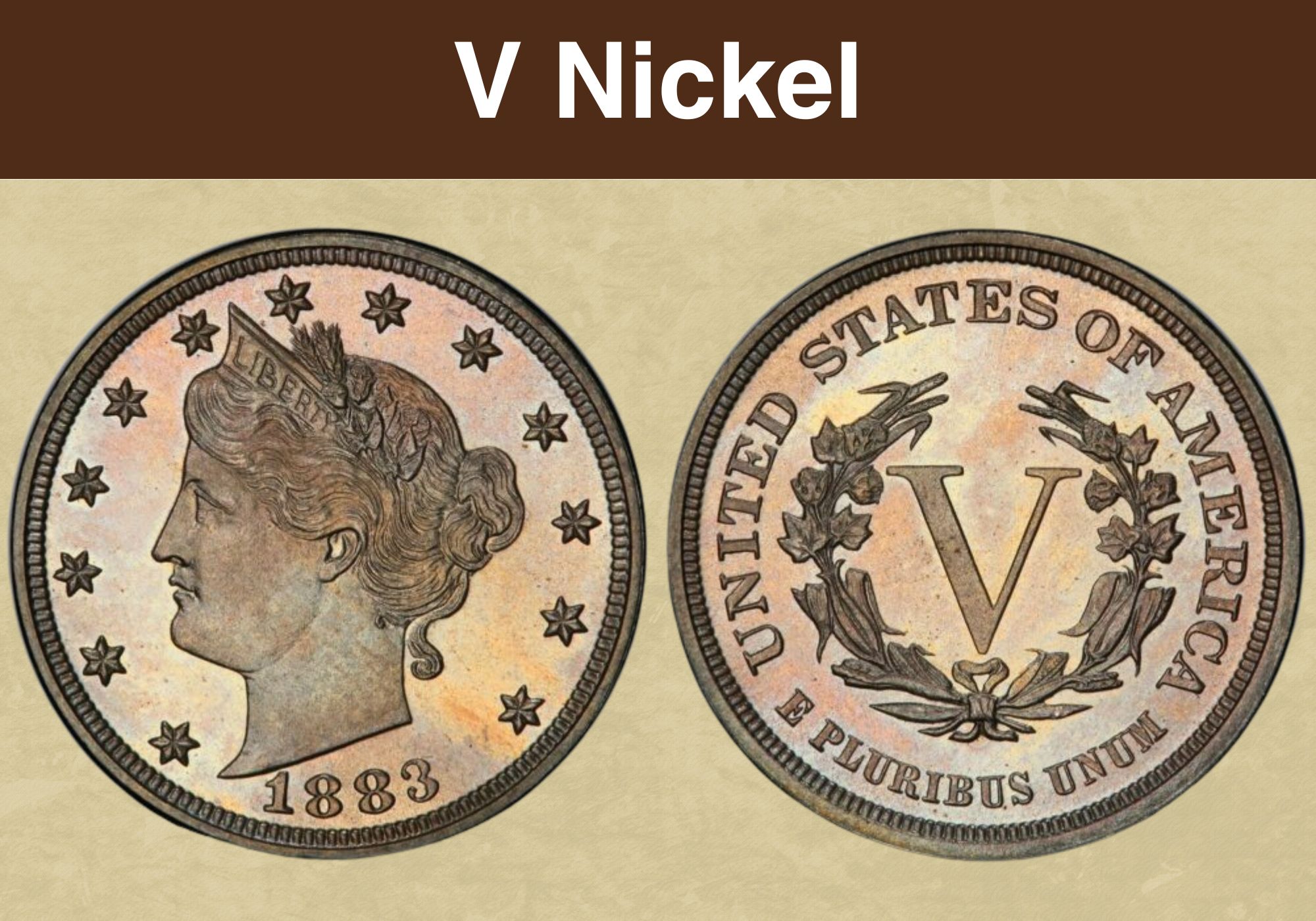
Coin Value Contents Table
Have you found a nickel with a large “V” on one side? If so, you’ll probably have noticed that it’s dated over a hundred years ago. So is it valuable? And how much might it be worth?
That’s what we’re going to find out! We’ll learn about the history behind the interesting design. We’ll investigate what factors influence the value of individual coins. And we’ll look at some of the interesting variants that are out there.
Ready to learn more? Then let’s get started!
V Nickel Value Chart |
||||
| Mintage | VF20 | XF45 | MS60 | MS65 |
| 1883 “No Cents” V Nickel Value | $16 | $30 | $75 | $375 |
| 1883 “With Cents” V Nickel Value | $70 | $110 | $235 | $650 |
| 1885 V Nickel Value | $1,100 | $1,650 | $3,000 | $8,000 |
| 1886 V Nickel Value | $450 | $750 | $1,500 | $5,500 |
| 1895 V Nickel Value | $60 | $125 | $250 | $1,250 |
| 1900 V Nickel Value | $15 | $60 | $120 | $550 |
| 1912 V Nickel Value | $15 | $60 | $120 | $450 |
| 1912 D V Nickel Value | $50 | $200 | $400 | $1,350 |
| 1912 S V Nickel Value | $550 | $1,500 | $2,250 | $3,500 |
| PR50 | PR60 | PR65 | PR67 | |
| 1883, 1885 Proof V Nickel Value | $700 | $1,050
Cameo: $1,200 |
$1,750
Cameo: $1,750 Deep cameo: $3,000 |
$3,500
Cameo: $5,750 Deep cameo: $22,500 |
| 1884 Proof V Nickel Value | $120 | $250 | $550
Cameo: $800 Deep cameo: $2,000 |
$1,600
Cameo: $3,750 Deep cameo: $27,500 |
| 1895 Proof V Nickel Value | n/a | $250
Cameo: $300 |
$550
Cameo: $800 |
$5,000
Cameo: $17,500 |
| 1900 Proof V Nickel Value | n/a | $250
Cameo: $300 |
$550
Cameo: $800 |
$1,600
Cameo: $3,250 |
| 1913 Proof V Nickel Value | n/a | n/a | $5,500,000 | n/a |
History of the V Nickel
The nickel with the large “V” on the reverse is more commonly known to coin collectors as the “Liberty head nickel”. The nickname comes from the image on the obverse – the head of Lady Liberty in profile.
The first of these nickels were produced in 1883, and general production ceased in 1912. However, five proof nickels were also struck in 1913, apparently in secret.
Like its predecessor, the Shield nickel, the V nickel was made of an alloy of copper and nickel. The Shield nickel, however, had proved difficult to strike successfully, leading to its replacement.
It was originally intended to produce new 1, 3 and 5-cent pieces at around the same time. The Mint’s Chief Engraver, Charles Barber, produced designs for all three denominations. But in the event, it was only the nickel that went into production.
The original brief for the new nickel specified that it should measure 22 millimeters across. Barber produced patterns accordingly.
However, it was later decided to shrink the coins to a diameter of 21.21 millimeters. That brought it closer to the size of the Shield nickel, which had measured 20.5 millimeters across. The new size, however, would soon cause problems.
It had not been considered necessary to add the word “cents” after the denomination on the reverse of the nickels. Both 1 and 3-cent pieces had been circulated successfully for years without any mention of cents.
But the size of the new nickel was similar to that of the gold 5-dollar coin. Enterprising fraudsters were quick to take advantage of this fact, plating the coins in gold and passing them off as the higher denomination.
The story has it that one sharp-witted villain used the coins to purchase items valued at 5 cents. On many occasions, the retailer gave him $4.95 in change. But apparently, he could not be charged with any crime, since he could argue that he’d tendered the correct amount, and the change was a gift.
Not surprisingly, the Mint was in uproar at the turn of events. Production of the nickel was halted, and new dies were prepared with the word “cents” added to the denomination.
The public responded to the change by hoarding the “no cents” variety, expecting the Mint to recall the coins and for them to become collectors’ items.
But that didn’t happen. And today, it is the “with cents” variant of the 1883 mintage that is the rarer and more valuable.
By 1900, the US economy was growing rapidly. This resulted in an increasing demand for nickels, which were being used in coin-operated machines.
For many years, the law required all nickels to be struck at the Philadelphia Mint facility. But in 1906, the legislation was relaxed to allow them to be produced at other locations.
It was not until 1912, however, that nickels were made anywhere but Philadelphia. That year saw the first nickels produced at Denver and San Francisco.
Also read: Top 10 Most Valuable Nickels Worth Money
Features of the V Nickel
The Obverse of the V Nickel
The design on the obverse – or “heads” side – of the V nickel is what gives the coin its alternative nickname of the “Liberty head nickel”. It shows the head and neck of Lady Liberty in profile, facing to the left as the coin is viewed.
The design was the work of Charles Barber, who was the Mint’s Chief Engraver from 1879 to 1917. Barber had been instructed to produce similar designs for three different denominations: the penny, 3-cent piece, and nickel.
He was also given a clear design brief. The obverse of the new coins should feature a classical representation of Liberty, together with the word “Liberty” and the date.
Barber’s design shows the word “LIBERTY” inscribed on the diadem worn by the goddess. Most of the circumference of the coin is ringed with stars, representing the states. And the date is at the bottom, curving parallel to the lower coin edge.
The Reverse of the V Nickel
The reverse of the very first V nickels struck in 1883 feature a large “V” in the center, the Roman numeral representing five.
Below it is a wreath, and below that, the Latin motto “E PLURIBUS UNUM”. The words mean “From the many, one”, and are a reference to the country’s birth as a union of states.
At the top of the coin, arching to follow the line of the upper coin edge, are the words “UNITED STATES OF AMERICA”.
In June 1893, the Mint responded to problems with fraud by changing the design. The word “CENTS” was added at the bottom, where the words “E PLURIBUS UNUM” had previously been. And the Latin motto was moved to the top, tucked beneath the name of the country.
Until 1912, all nickels were struck at the Mint facility in Philadelphia, and none had a mint mark. But that year, nickels were produced at Denver and San Francisco too, and marked with a “D” or an “S” accordingly. You’ll find any mint mark to the left of the word “CENTS”.
Other Features of the V Nickel
The V nickel in its natural state had a silver color and a plain edge. But some 1883 coins were plated gold by fraudsters attempting to pass them off as 5-dollar pieces. And some of those also had reeds – grooves running parallel to the coin faces – added to the edges too.
The idea was to make them look like 5-dollar coins. It was ironic, as reeded edges had originally been developed as an anti-fraud measure! The lines were intended to allow anyone to see at once if metal had been clipped from the coin edge.
You can find out more about the design and variants of the V nickel in this YouTube video from World Numismatic News.
Also read: Top 17 Most Valuable Buffalo Nickel Worth Money
V Nickel Grading
| # | Grade |
|---|---|
| 1 | Basal State-1 |
| 2 | Fair |
| 3 | Very Fair |
| 4, 5, 6 | Good |
| 7, 8, 10 | Very Good |
| 12, 15 | Fine |
| 20, 30 | Very Fine |
| 40 | Extremely Fine |
| 50 | About Uncirculated |
| 60 | Mint State |
| 65 | Mint State |
| 70 | Mint State |
Please check our grading guides to know your coin scale, It’s the necessary step to know the exact value of your coin.
Check out now: How to Grade Liberty Nickel?
V Nickel Values Guides
1883 “No Cents” V Nickel Value
The first of the V nickels entered circulation on February 1st 1883. But the absence of the word “cents” from the design presented an open goal for fraudsters. Soon, numerous gold-plated versions of the coin were being circulated and passed off as 5-dollar pieces.
After five months, the Mint halted production of the nickels. The design on the reverse was amended to add the word “CENTS” at the bottom. The Latin motto “E PLURIBUS UNUM” was also moved from the bottom of the reverse, to near the top.
The nickels struck from February to June 1883 are known as the “No cents” variety. Almost 5.5 million of them were made.
The problems with fraud meant there was a general expectation that the coins would be recalled. The public responded by hoarding them, expecting them to become collectable. The result is that more of them survive in excellent condition today than the “With cents” variety.
You can pick up a coin graded VF20 (the letters stand for “very fine” for around $16. That increases to $30 at XF45 (“extremely fine”).
If you’re looking for a coin in mint state – i.e., one that’s never been circulated – you’ll need to pay more. Prices start at $75 for an example graded MS60, rising to $375 at MS65, the lowest grade at which a coin is judged to be a “gem”.
The finest examples to have come to light are graded MS67+. The PCGS has certified 15 nickels at this level, and values them at $5,000 apiece.
Also read: Top 17 Most Valuable Jefferson Nickels Worth Money
1883 “With Cents” V Nickel Value
The “With cents” variant of the 1883 V nickel was struck in far higher numbers. Over 16 million of them came out of the Philadelphia coin presses.
Around three times as many survive at all grades as the “No cents” variant – about 30,000. But numbers in mint state are much lower, at just 2,000 coins. That’s a tenth of the number of centless examples at equivalent grades.
And gem quality examples are even rarer, believed to number only around 500. That compares to around 5,000 of the “No cents” variant.
At all grades, the “With cents” variant commands higher prices. You can expect to pay around $70 for a coin graded VF20, rising to $110 at XF45, and $235 at MS60. A gem MS65 example is worth around $650.
And the cream of the crop are two coins graded MS67+ (out of a maximum 70 on the coin grading scale). The PCGS values those at $25,000 each.
Business Strike V Nickels, Key Dates Values
Some mintages of V nickels are particularly sought after by collectors. These include the 1885, 1886 and 1912 S. While most mintages saw more than 10 million coins struck, all three of these years saw much lower numbers.
In 1886, the mintage was 3.3 million coins, all struck in Philadelphia.
And the previous year, the number was fewer than 1.5 million.
Only the 1912 S mintage was lower, with just 238,000 coins. But fewer of the 1885 nickels were saved in their year of issue, meaning that they generally fetch the highest prices.
Even at VF20, you’ll need to pay four figures for an 1885 V nickel. The PCGS values a coin at that grade at $1,100, rising to $1,650 at XF45, and $3,000 at MS60. The finest examples certified to date are graded MS67. The eight coins at that level are each valued at $35,000.
For an 1886 nickel, you’ll need to spend at least $125 for a coin graded 2. At VF20, that rises to $450, and to $750 at XF45. For a mint state example, you’ll be looking at spending a minimum of $1,500.
The crème de la crème of the 1886 mintage are four coins graded MS67. Their scarcity means they’re each worth a cool $75,000.
For the 1912 S, the minimum value is $120 for a coin graded 2. Mint state examples start at $2,250. And the very finest to have so far come to light are graded MS66+, and worth around $12,500 apiece.
1883 Proof V Nickel Values
The Mint struck proof nickels every year from 1883 to 1912. Values tend to range from around $250 for examples graded PR60, to $600 at PR65. The very finest coins in each mintage command a premium. And some mintages are particularly valuable at all grades.
The 1883 and 1885 mintages start at around $700 for coins graded 50 (proof coins that entered circulation). Values breach four figures ($1,050) at PR60, and rise to $3,500 at PR67.
Coins assessed as cameos or deep cameos command a premium. An 1883 or 1885 proof V nickel graded PR67 deep cameo is worth around $22,500.
But the rarest coins of all are the five proof nickels believed to have been produced in secret at the Mint in 1913.
The lowest grade of one of these coins is AU55, and that’s valued at $2.5 million. And the top graded coin is graded PR66, and valued at a staggering $6.25 million.
Also read: 14 Most Valuable Nickel Errors Worth Money
Where to Sell Your 1883 V Nickel ?
Now that you know the value of your coins, do you know where to sell those coins online easily? Don’t worry, I’ve compiled a list of these sites, including their introduction, pros, and cons.
Check out now: Best Places To Sell Coins Online (Pros & Cons)
FAQs
What is a 1912 V nickel worth?
That depends on its quality and mint mark. The most valuable is the 1912-S – look for the “S” on the reverse, to the left of the word “CENTS”.
A 1912 nickel with no mint mark in poorer condition will be worth only a few dollars. If there’s a D, it will be worth from $10 upwards. And either of those coins in mint state – that is, with few signs of wear – will be worth over $100.
But a 1912-S nickel is considerably rarer. Even a coin in the poorest condition will be worth at least $120. And the very finest examples to have come to light so far are worth $12,500 apiece.
What is the most valuable V nickel?
The most valuable V nickels are dated 1913. Only five are believed to have ever been made. Their values range from $2.5 million to $6.25 million.

